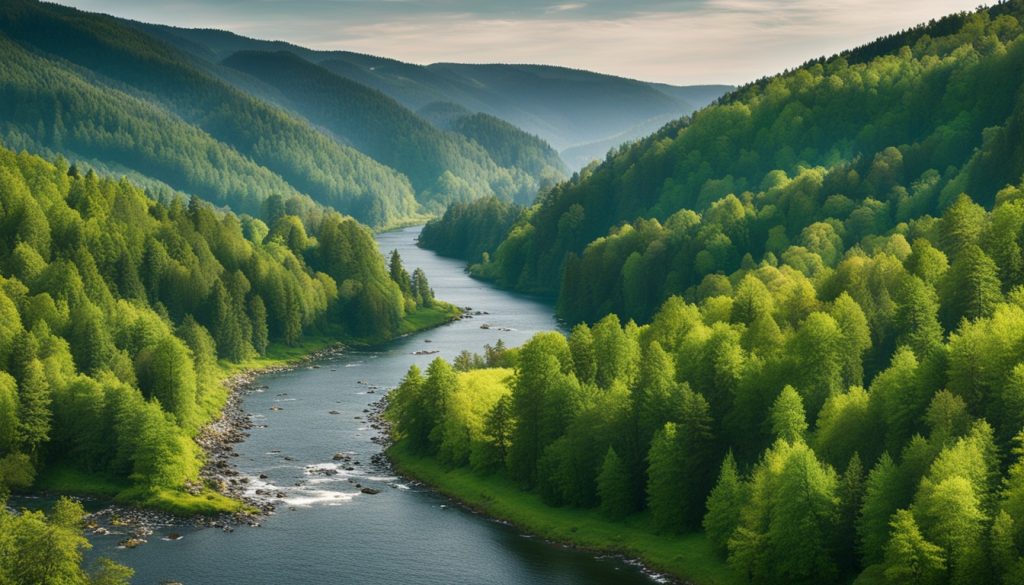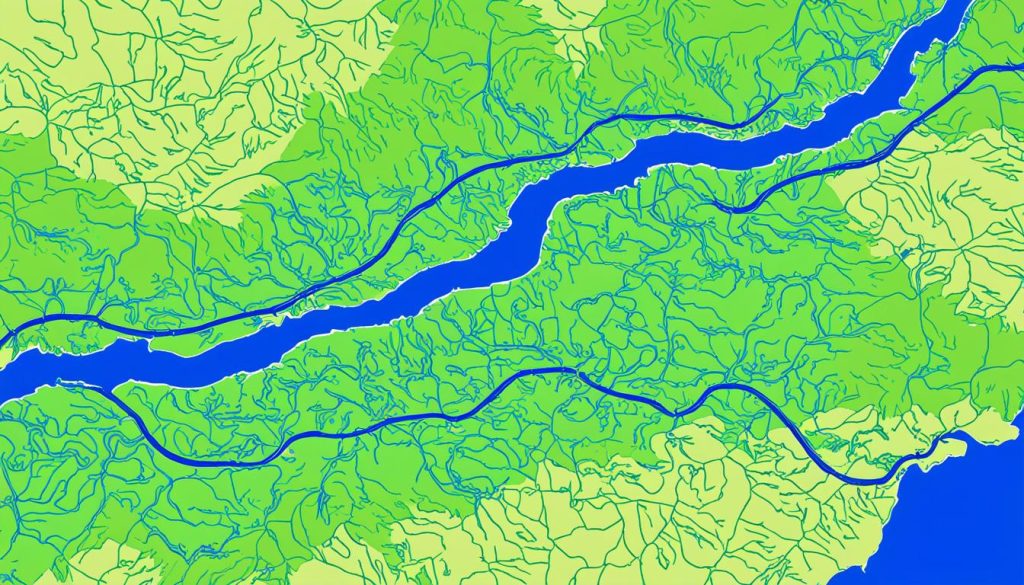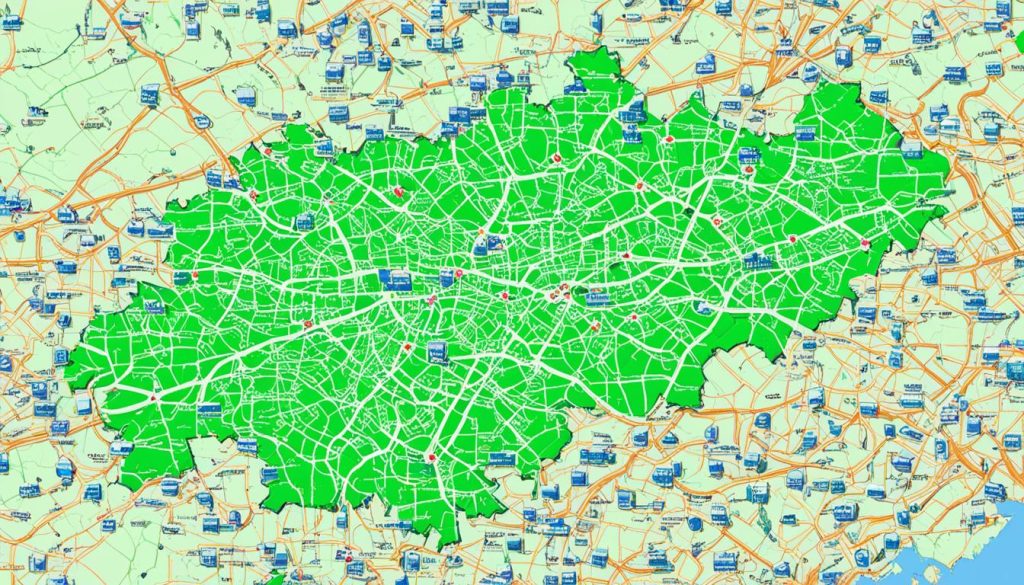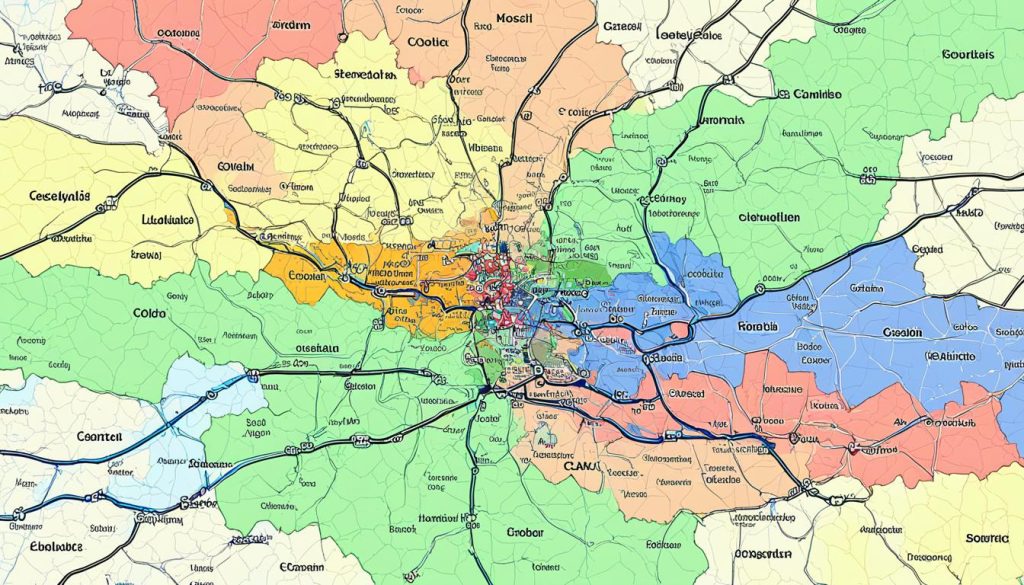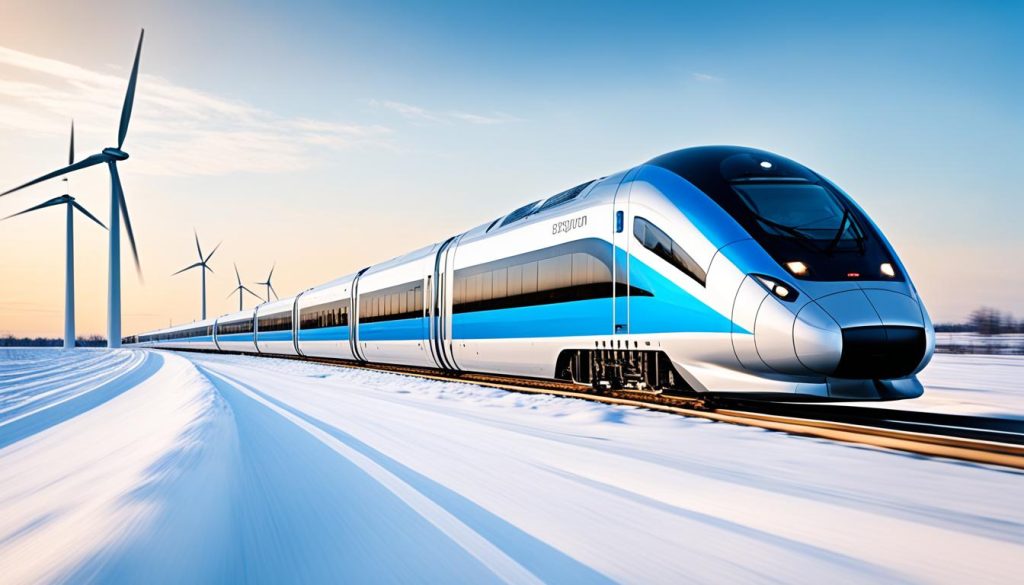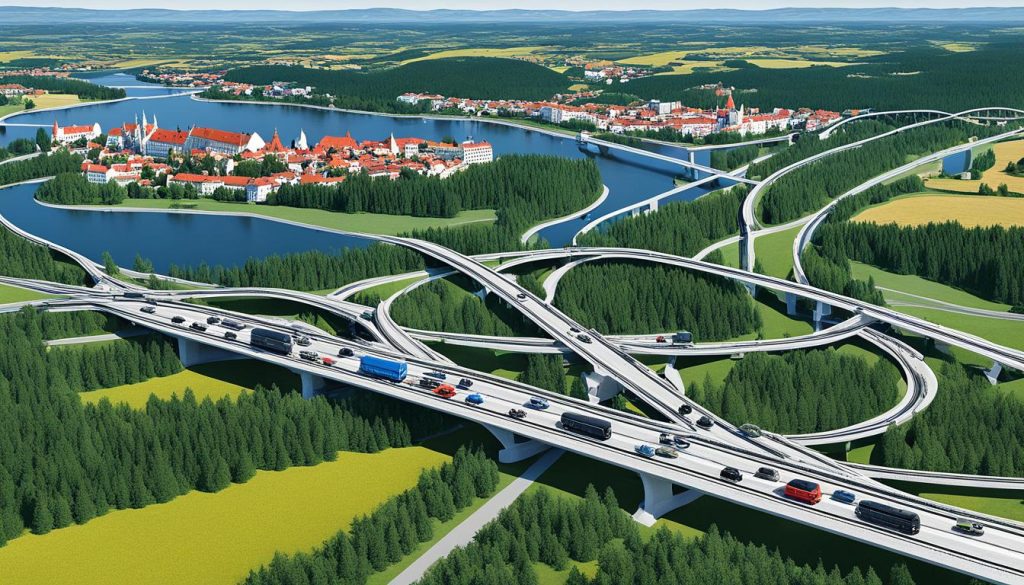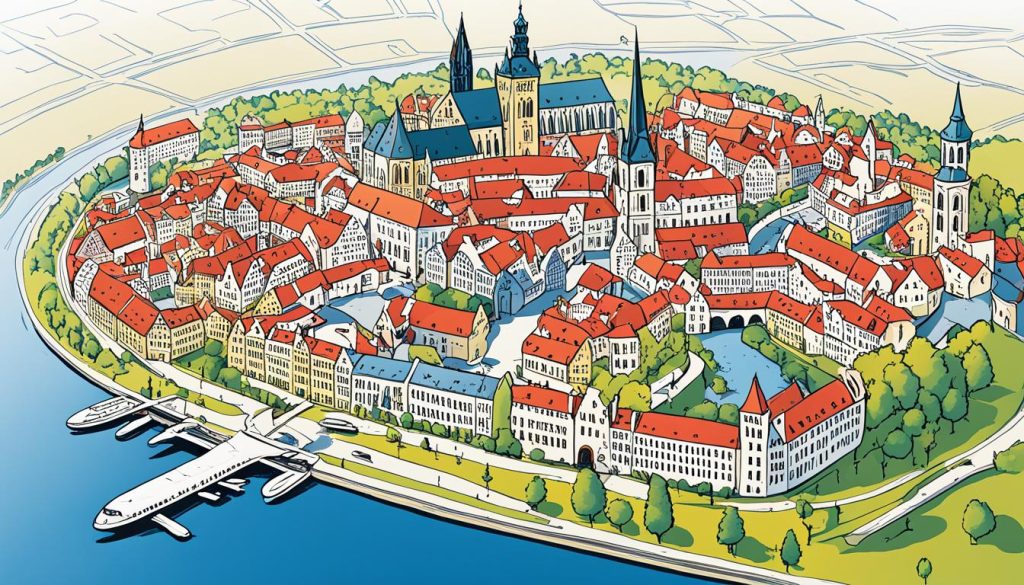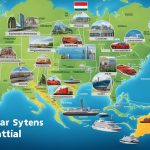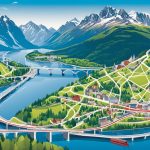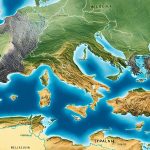Exploring the geography and infrastructure between the Czech Republic and Nordic Countries reveals interesting differences. The Czech Republic, in Eastern Europe, has a rich culture. It’s rapidly developing its infrastructure at the continent’s heart. Nordic Countries, at Northern Europe’s top, show vast landscapes and sophisticated infrastructure. This is because of their unique locations.
The story of Czech Republic versus Nordic Countries is more than geography. It’s about how each places uses its surroundings to grow and succeed. Czechia, in Eastern Europe, looks forward to urban growth. The Nordic nations use their natural resources well. Each area is building its society with unique infrastructure ideas.
Geographic Overview of the Czech Republic and Nordic Countries
Exploring Eastern Europe geography and Northern Europe landscape reveals a story of contrast and natural beauty. The Czechia area, with its 78,870 km², is landlocked and rich in Eastern European culture. Meanwhile, Norway’s vast 385,203 km² features striking fjords and an extensive coast, showcasing its northern charm.
Prague is the heart of Czechia, buzzing with history and today’s energy. It’s where politics, economy, and culture blend seamlessly. Oslo, Norway’s capital, offers stunning views amid its critical role in the country. It symbolizes the rugged beauty of Northern Europe.
- Prague shines with Czech traditions, moving beyond past divisions to a lively democratic state.
- Norway captivates with its natural beauty and a government system that reflects its deep-rooted values.
This look at their geography tells more than just their size. It’s about their cultural depth, how they govern, and their bond with nature’s wonders.
Natural Landscapes: Forests and Agricultural Land
The Czech Republic and the Nordic countries have different natural settings. Each one shows off its own kind of environment. Looking closer, we see how forests in the Czech Republic differ from those in the Nordics. We also notice differences in how they use their farming land.
Forest Coverage in Czechia vs Nordic Regions
In the Czech Republic, forests cover 34.4% of the land. These woods are central to Czechia’s nature and are key for industry and fun. Looking north, the Nordic countries show off even more forests. For example, Sweden’s woods cover 68.7% of it, showing the big role of forests there in culture and the economy.
Utilisation of Agricultural Lands
When it comes to farming, the story changes. In Czechia, farming uses 54.8% of the land. This shows a big focus on agriculture, with lots of fields across the countryside. In the Nordic regions, like Sweden, only 7.5% of the land is for farming. This highlights how geography affects farming methods and land use.
So, the contrast between these regions is clear. They have different ways of managing their natural and farming resources. Each has its own approach to using what they have.
Water Bodies: Influence on Geography and Lifestyle
When we look at water bodies and their geography, there’s a clear difference between Czechia and the Nordic areas. Czechia’s rivers and streams create a vast network. It stretches for around 726 kilometres. These waterways are vital for trade and cultural exchanges. They support the country’s unique freshwater life too.
The Nordic countries, however, connect with water through their coastal lifestyle. Norway alone boasts a coastline that stretches over 1,577 kilometres. It’s where the rough landscapes meet the North Sea. This coastal area helps nurture a diverse marine life, which is crucial for local cultures and economies. Fishing and sea trade are big parts of this.
Looking closer at how water geography influences everyday living, we see different life experiences in Czechia and the Nordic region:
- The Vltava and Elbe rivers are key to Czechia’s network, boosting business and providing leisure spaces. These are essential for tourism in a country without a sea.
- Meanwhile, the Nordic’s seaside setting allows for deep sea exploration and studies. This leads to a greater knowledge of undersea life.
- The vast waters have also fostered sea-related skills and customs. These are celebrated in Nordic festivals and are part of their heritage.
These cases show us how water bodies are more than just part of the landscape. They shape a country’s culture, economy, and lifestyle in profound ways.
Population Densities and Urban Growth
When we look at Czechia and the Nordic countries, we see big differences in how many people live in areas and cities. Czechia is more crowded, with lots of people living in a small space. This means we need careful planning to build things like roads and houses for everyone.
Demographics and Population Distribution
The number of people in an area in Czechia compared to the Nordic countries shows different living patterns. Czechia has 135.3 people living in each square kilometre, meaning many live in cities. This affects everything from how many houses are built to the kinds of public services needed. On the other hand, the Nordic countries have fewer people per square kilometre, like Norway with only 14.2. This means they live more spread out, which changes how resources and services are managed.
Urbanisation Trends and the Biggest Cities
Urban growth in Czechia and the Nordic countries shows us different ways cities are growing. Prague is a prime example of fast city growth, showing how cities in Eastern Europe are expanding. In contrast, Nordic countries grow their cities with a focus on being green and sustainable. Oslo shows how cities in Northern Europe grow but keep the environment in mind. This movement towards cities is shaping how these regions will look in the future, driven by people looking for better jobs and living conditions.
The Contrast in Climate Patterns
Looking at the Czech Republic climate against Nordic weather patterns shows clear differences. Czechia enjoys a temperate climate with average temperatures around 13.5°C. The Nordic countries, however, have a cooler mood, averaging 9.6°C in Norway due to maritime and continental influences.
These temperature differences shape Scandinavia seasons in unique ways. In Czechia, winter brings cosy city squares and snowy landscapes. Summer there is warm, perfect for enjoying outdoor fun and cultural events.
In Scandinavia, winters are dark and cold but full of light festivals. Their summers, with almost endless daylight, are great for adventures and parties.
The weather affects lives and how areas are built in these European spots. In Czechia, there’s a need for heating in winter and cooling in summer. Nordic areas focus on strong heating systems and dealing with lots of snow and ice.
- Building materials and designs consider these extreme weathers.
- How cities handle snow or beat the heat shows their climate planning.
Seeing the Czech Republic climate and Nordic weather patterns side by side highlights their environmental differences. These factors shape how people live in these areas. With changing climates worldwide, understanding these differences is more important than ever.
Exploring the Economic Landscapes
The global economy is always changing, making it crucial to measure its health. When we look at Czechia and the Nordic countries, we see interesting differences and similarities. These highlight the area’s wealth. We’ll dive into different economic factors like GDP and sector outputs. These factors are key in defining a nation’s living standards and economic strength.
Gross Domestic Product (GDP) Comparisons
GDP is essential for understanding a country’s economic output. Czechia’s GDP shows its economic growth in Central Europe, at about $290,528 million. But, the Nordic countries, especially Norway, have much higher GDPs. Norway’s GDP is around $579,422 million. Looking at GDP per capita sheds light on economic output per person. It shows how both areas generate wealth and resources.
Agriculture and Industry: Economic Contributions
Czechia and the Nordics differ in their main economic sectors. Czechia values its agricultural sector, based on its rural areas. This sector supports its traditional economy. The Nordics, with their green lands and sea history, adapt their farming to their environment. Yet, both place varying importance on their industrial sectors. Czechia’s industry stands out, thanks to its history and resources.
The balance between these sectors shows how economies work. The focus on the number “8” suggests a balanced economic approach. Each nation uses its strengths to improve its global economic role. This balance affects GDP and improves life and financial security for people.
Disparities in Infrastructure: A Detailed Analysis
To truly grasp the differences in infrastructure between the Czech Republic and the Nordics, we must delve into their development frameworks. The real difference lies not in the miles of roads but in their planning’s efficiency, quality, and vision.
When we look at transportation, Czechia and the Nordics have taken very different paths. Czechia boasts 129,418 km of roads, far more than Norway’s 95,120 km. This shows a strong focus on road transport in Central Europe. But we need to consider what these numbers mean in terms of quality and access.
-
Czechia’s roads and railways are vast, but we must check how well they are maintained and connected.
-
Does a longer road network mean better movement for people, or just crowded cities?
-
In the Nordics, there’s a strong emphasis on quality and eco-friendliness. How does this affect the people using them?
Looking at public utilities is also key to understanding infrastructure. How water, electricity, and waste services are delivered shows us the health of a society and how it copes with urban and environmental challenges.
-
In the Czech Republic, the utility infrastructure has to be efficient for its busy cities and broad areas.
-
The Nordics are ahead in using advanced tech and green resources in their utilities, showing a commitment to the planet.
Infrastructure isn’t just about physical structures. It’s also about how these structures support or limit social and economic growth. We need to see how a region’s setting, strategic efforts, and the effects on daily life interact. It’s here, in everyday life, that we find the true scale of differences.
An in-depth analysis goes beyond numbers. It looks at how different areas respond to new challenges, tech, and climate changes. Czechia and the Nordics might develop differently due to their unique goals and landscapes. Their development tells a story of their history and future visions.
A Comparative Look at Transportation Networks
Modern societies thrive on being able to move around easily and with speed. Looking closely at transport systems in the Czech Republic and Nordic countries reveals interesting differences. The Czech Republic enjoys a robust public transport system, while Nordic countries prefer private cars.
Integrating Public and Private Transport Systems
Czechia has a rich array of public transport, making travel easy. This network helps people move around smoothly. In contrast, Nordic countries see cars as a symbol of freedom. Both systems reflect each culture’s values and travel preferences.
Rail and Roadways: Connectivity Across Borders
Czechia’s railways stretch over 9,548 km, ideal for both local and international trips. This network is crucial for trade and cultural ties. Meanwhile, the Nordics have a strong network of roads. These paths wind through the land, with airports linking the skies.
Both regions work towards seamless travel and mobility. Their efforts show the balance between infrastructure, local needs, and how society moves. This balance shapes modern life’s rhythm.
Educational Systems: Foundations for Future Growth
The education systems play a huge role in a society’s growth. This is where the Czech education system and Nordic educational excellence stand out. They have great academic infrastructure and invest a lot in education. This leads to high literacy rates, showing their commitment to educating their people.
In the Czech Republic, education from a young age is very important. They have well-equipped classrooms and extensive libraries. There’s a big focus on STEM subjects, which meets modern standards.
- Curricula mix theory with practical skills
- All get access to good education, following an inclusive approach
- They aim to keep literacy rates high, for a well-educated public
Nordic countries are known for their excellent education too. They focus on critical thinking and solving problems creatively. This shows their values of innovation and equality in society.
- Education is for all, no matter their background
- They work on having a good learning environment. This includes small class sizes and focusing on students.
- Their high literacy rates come from a culture that loves reading and learning continuously.
Looking at Czech and Nordic education, we see they both want to empower the next generations through learning. Though their cultures are different, they both show how strong educational policies and investments can really help society grow and develop.
Healthcare Infrastructure: Assessing Hospital and Healthcare Services
An in-depth look shows how healthcare systems in the Czech Republic and Nordic countries differ and compare. They are known for their strong healthcare services. This offers a closer look at Nordic hospital beds, physicians per capita, and the healthcare quality people receive.
In the Czech Republic, there are a lot of hospital beds available for people. They have 6.62 beds for every 1,000 people. This is much more than in Nordic countries. For example, Norway has only 3.53 beds for the same number of people. But having more beds is just one part of the healthcare story.
- The number of physicians per capita is crucial in understanding healthcare services. More doctors mean better care and improved healthcare quality for everyone.
- Good healthcare isn’t just about numbers. It includes how well treatments work, if patients are happy, and new medical tech.
- Differences in healthcare strategies and policies between these places affect how Czech healthcare services and Nordic healthcare deals with growing needs.
This deeper look into healthcare shows the various ways healthcare systems work. It highlights what they do well and where they can improve. It also shows how ready they are to meet people’s health needs.
Compare Geography and Infrastructure between Czech Republic and Nordic Countries
The Czech Republic and Norway differ not just in numbers but in quality of life and governance. These factors show how stable and healthy a country is. They are shaped by many social and political elements. It’s interesting to see how these aspects make each country unique.
Assessing the Quality of Life Indicators
Norway beats the Czech Republic in life expectancy, with 82 years for men and 85 for women. This shows Norway has better healthcare and lifestyle. On the other hand, the Czech Republic also has good numbers but is slightly behind. Moreover, Norway’s positive migration rates show its strong economy and appeal.
Governmental Policies Influencing Geography and Infrastructure
Comparing the Czech Republic and Norway shows how much policies matter. They affect geography and infrastructure deeply. Norway focuses on the environment, and Czechia on building things. These policies reveal each country’s governance style and shape their land and cities. Public policies do more than make laws. They create the spaces where people live their lives.
- Life expectancy in Czechia vs Norway: A comparative view on national health standards.
- Examining birth and death rates to understand population dynamics.
- Analysing migration rates and their implications on demographic trends.
- The nuances of public policies and their consequent impacts on infrastructure and social stratification.
Telecommunications and Technology: Poles Apart?
The story of telecom between Czechia and the Nordic countries shows big differences. In Czechia, people often use traditional landline connections. On the other hand, folks in the Nordic countries prefer using mobile phones. This situation shows how different areas embrace technology in their own unique ways.
In the Nordics, there’s a big push for broadband, showing a move towards a wireless world. This move suggests they are ready for future tech changes. Czechia, however, finds a balance with both new internet users and old-school copper wires.
- Disparity in landline utilisation versus mobile cellular adoption
- Broadband access as a benchmark of digital inclusivity
- Telecommunication infrastructure as a fulcrum of societal connectivity
The bullet points tell us about the telecom plans in these areas and their impact on society. Czechia is careful in its telecom growth. Meanwhile, the Nordics are jumping into a mobile-first approach. This approach might change our view of connectivity in the future.
Energy Production and Consumption: A Green Perspective
Making our way of living more sustainable is crucial because of global environmental issues. Czechia and the Nordics are leading examples in the energy world. Czechia’s energy reflects its history, while the Nordics show what’s possible with green energy. We will look at how these areas shape the future of sustainable energy.
Renewable Energies and Sustainability Goals
Comparing Czech and Nordic energy shows big differences in approach. The Czech Republic uses traditional energy but is also focusing on being more sustainable. Denmark, for example, is a leader in wind energy, pushing forward green innovation.
- The emphasis on solar and wind power as pillars of Czech renewable energy.
- Nordic nations propelling the uptake of hydropower, wind, and bioenergy solutions.
- Legislative measures and environmental policies fostering a green transition.
Both areas are changing their energy sectors to meet sustainability goals. They follow global plans like the Paris Agreement and the SDGs.
Energy Imports and Exports: Balancing the Scales
Looking at energy trade shows how countries stand on energy independence. The Czech Republic depends on energy imports, unlike the self-sufficient Nordics. Norway’s energy exports, from hydroelectric and wind resources, show a strong energy balance.
- Scrutiny of the Czech Republic’s energy mix, spotlighting reliance on imported fuels.
- Insight into Nordic strategies that contribute to a surplus in energy exports.
- Critical assessment of infrastructural and economic impacts resulting from these trends.
In our detailed look at number 15, we reveal the big impacts of energy sourcing on economies and Europe’s energy market.
Environmental Policies and their Geographical Impact
The Czech Republic and the Nordics are transforming their landscapes with ecological policies. Changes in weather and hotter climates make it vital to plan for the environment. These areas use special Czech Republic initiatives and Nordic environmental strategies to save their regional ecosystems and help the world.
In the Czech Republic, fighting air pollution and better waste management are key. On the other hand, the Nordics lead in eco-friendly approaches. They focus on clean energy and cutting down greenhouse gas emissions to save nature.
- Advancements in solar and wind technology form the cornerstone of the Nordics’ renewable energy scheme.
- Investment in public transportation and electric cars reduces fossil fuel dependency in Nordic cities.
- Practices like sustainable logging and reforestation are an integral part of ecological policy in the Czech Republic.
- Education campaigns aimed at enhancing public awareness and participation in recycling and conservation initiatives.
These efforts weave together a mix of policy and local actions crucial for growth. They show a dedication to building a greener tomorrow, mindful of our ecosystem. Through these varied strategies, the Czech Republic and the Nordics lead in environmental care. They serve as models for the world.
Conclusion
This article gives a deep dive into how the Czech Republic and Nordic countries compare geographically and in terms of infrastructure. We looked at the Czech Republic’s landlocked areas and Norway’s wide fjords. This shows how the land shapes a region’s character and progress. We also saw how different areas focus on transportation, healthcare, and education to support their people.
The piece highlights the importance of good regional planning and smart investments. These are key for improving life quality in European areas. Both the Czech Republic and the Nordic countries aim for innovative infrastructure solutions. Despite their differences in landscapes and resources, they share this goal. Their efforts show how adaptable and creative strategies can overcome various challenges.
Furthermore, comparing Czech and Nordic regions is more than just an academic task. It encourages working together across different fields for the benefit of Europe. By sharing knowledge, these regions show the importance of cooperation. It leads to better understanding and progress for everyone. The article supports the idea of continually sharing ideas and benefits from international discussions.

